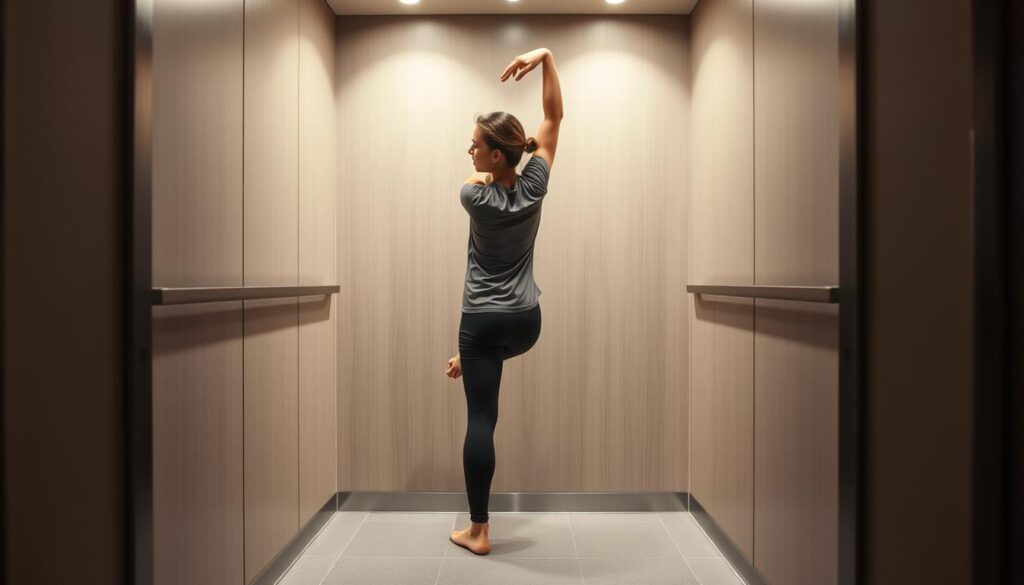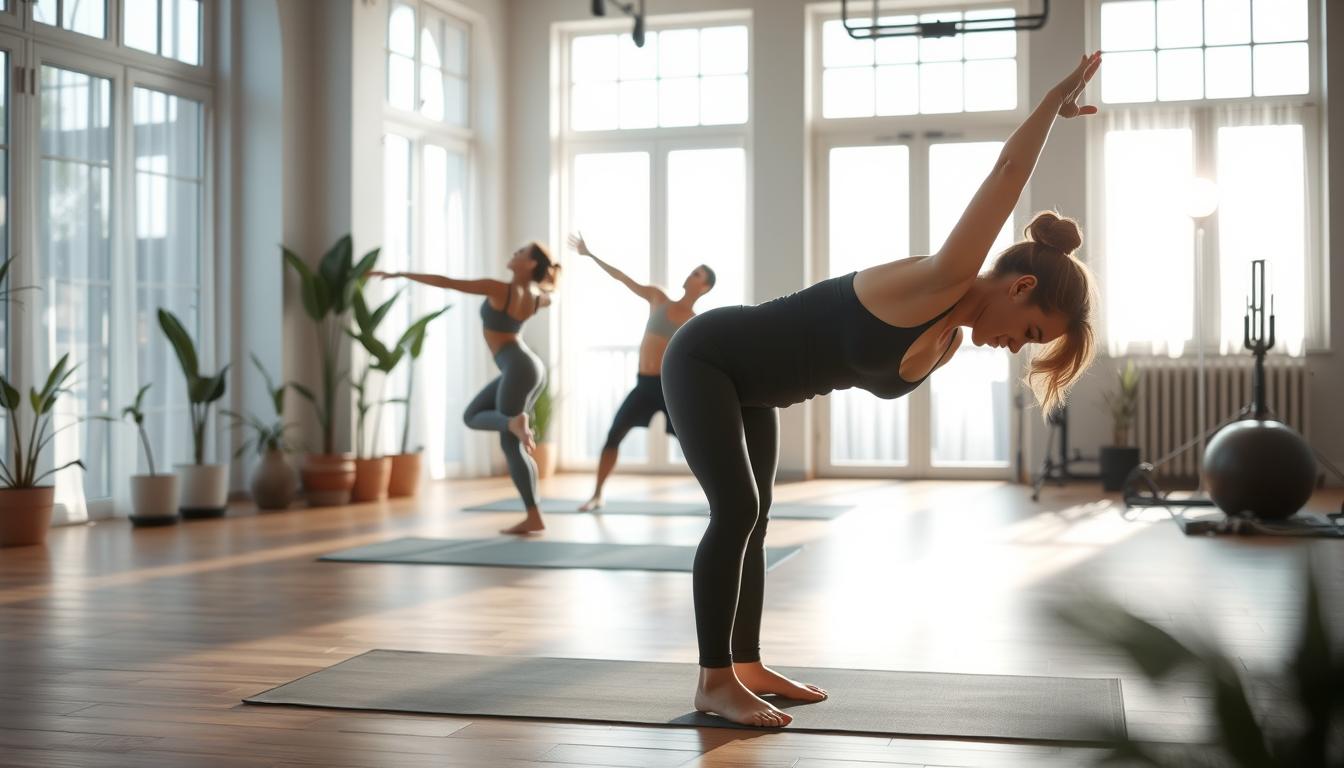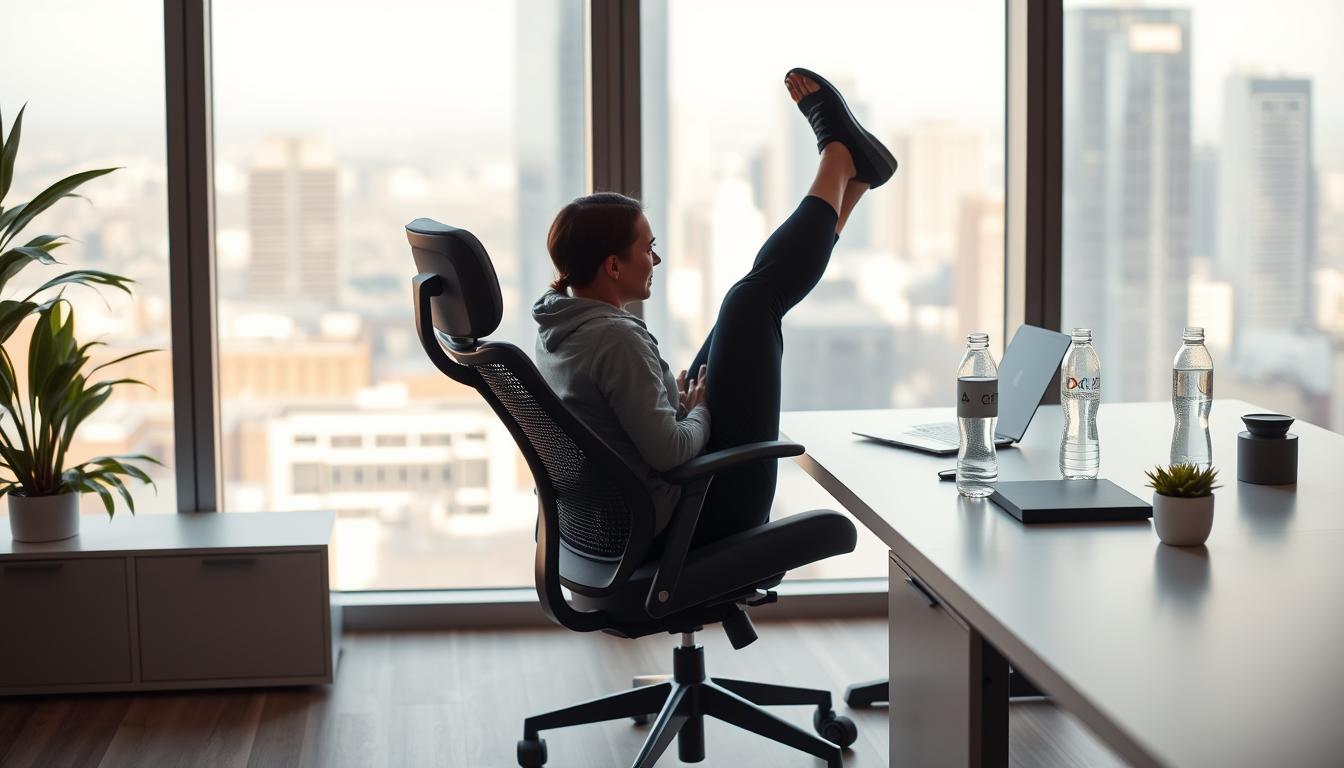Finding time to exercise is tough in today’s busy world. But, it’s easier to fit fitness into your day than it seems, like when you’re in the elevator. This piece gives useful tips for staying active in small spaces. With quick exercises ready to go, keeping fit on the move is not only possible but fun too.
Adding small exercises in the elevator works important muscles like the erector spinae, glutes, and core. You can do simple moves like standing on one leg or basic strength workouts. Every little bit helps. Doing these regularly helps with your posture, back support, and overall health. Let’s explore how to make your elevator time count!
The Importance of Daily Movement
Moving daily is key to keeping your body healthy. It helps you maintain your weight, fight diseases, and feel better overall. Fitting movement into a busy day might seem hard, but even small steps can make a big difference over time.
Integrating Physical Activity into Your Routine
It’s important to find ways to stay active. Simple actions, like walking while on the phone or taking stairs, are good for your health. Making exercise fun and social helps you do it more often. Here are easy exercises to try:
- Leg Curls: Stand tall, shift weight to one leg, bend the other leg at the knee, hold for 10 seconds, and repeat on the other leg.
- Glute Squeeze: Stand straight, contract glutes, hold for 3 seconds, and repeat throughout the ride.
- Shoulder Shrugs: Lift shoulders toward ears, hold for 5 seconds, and repeat to strengthen trapezius muscles.
- Praying Stretch: Press palms together, move elbows apart, lower hands to waist, hold for 10-30 seconds, and repeat.
- Calf Raises: Stand straight, rise onto toes, squeeze calves, hold for a few seconds, and lower.
- Isometric Shoulder Exercise: Press fist against elevator wall, hold contraction, and repeat with the other arm.
Finding Opportunities for Movement
Looking for chances to move during your day keeps you active. Choosing the stairs can boost heart health and tone muscles. This way, you could burn up to 5 calories a minute and manage your weight better. Adding simple exercises and being mindful in daily life also improves your mental health.
Why Use the Elevator for Fitness?
Fitness can turn into a fun part of your day. Even something as simple as an elevator can be a fitness tool. Using those short elevator moments for quick activities can boost your health big time.
Transforming Mundane Moments into Fitness Opportunities
Everyday moments are chances to get fit. Like when you’re waiting for an elevator. You can do simple exercises, like standing straight and tightening your stomach. This makes waiting time into a fitness moment.
Benefits of Using Stairs vs. Elevators
Choosing stairs over elevators is really good for your health. It decreases heart disease risk by 39% and can keep your heart healthy by lowering stroke risks. If you climb more than five flights daily, you lower your heart disease risk by 20%. This habit boosts your heart health and strengthens your muscles.
Stair climbing is like a mini workout. It combines aerobic exercise with strength training, toning muscles and burning fat. It also makes you more flexible and boosts your health by helping your blood pressure and insulin levels. Even though elevators are handy, stairs offer a better workout.
Elevating Your Fitness in the Elevator
Exercising in elevators is a smart way to fit workouts into a busy day. It means you don’t need a lot of time to stay active. Elevator exercises boost your heart rate, make your muscles stronger, and help you feel more energetic.
Simple Exercises to Perform in an Elevator
You can stay active in a small space with some easy exercises during elevator rides. Here are a few:
- Calf Raises – Stand with your feet shoulder-width apart and rise onto your toes, then lower back down.
- Squats – With feet hip-width apart, lower your body as if sitting back into a chair, then return to standing.
- Isometric Holds – Press against the elevator wall or use the handrails to perform isometric exercises, targeting your arms and core.
Creating a Quick Routine
A quick fitness routine makes your on-the-go workouts more effective. Plan to do certain exercises at different times of the day. You could do calf raises in the morning and squats in the afternoon. This plan lets you exercise regularly, even when you’re busy, without feeling stressed.
Tips for Making the Most of Your Elevator Time
Using elevator time well can really help with your fitness. Adding fitness breathing techniques improves oxygen flow and performance. Doing bodyweight exercises in an elevator uses space well for strength building, no gym needed.
These methods help you get the most out of your workout time.
Breathing Techniques to Enhance Your Workout
Using the right breathing techniques can boost your workout a lot. Breathe deeply and control your breaths during exercise. It keeps your energy up while doing exercises.
Diaphragmatic breathing is especially good for endurance. It’s helpful during squats or leg lifts.
Using Body Weight for Effective Resistance
Bodyweight exercises in an elevator can change your workout for the better. Focus on moves like squats and push-ups that work many muscles. Try for 6-15 reps each time for good resistance training.
Isometric holds, like pressing against the elevator wall, add extra benefits. Adding these to your routine makes the most of your time.
Staying Active at Work
Moving around during the workday is good for your body and can also help you do better at your job. Introducing things like walking meetings and desks that let you stand helps cut down sitting time and supports employee health. Making time for quick activities throughout the day really adds up in keeping you fit.
Walking Meetings and Stand-up Workstations
Walking meetings mix work talks with getting steps in. This helps come up with new ideas and keeps people interested. Using desks that let you stand keeps you on your feet while you work, adding more chances to move around.
Utilizing Breaks for Quick Workouts
Breaks are perfect for a fast exercise session. Here are some exercises you can do:
- Desk pushups to target triceps and chest, done in 10-20 reps.
- Calf raises to improve blood flow while standing, lifting heels off the ground.
- Squats engage the quads, glutes, and hamstrings; aim for 10-20 reps.
- Desk planks to strengthen the core and shoulders, held for 30 seconds or more.
- Side lunges to work quads, hamstrings, and adductors, performed in 10-20 reps.
- Short yoga poses, like Tree Pose, strengthen legs and improve balance.
- Buttock pinches and abdominal flexes can activate key muscle groups while standing.
- Stretching exercises for hamstrings and quads enhance flexibility and prevent injuries.
Use every break well, like taking stairs instead of an elevator, or a quick walk to the water cooler. Small activities add up, helping you reach fitness goals. Having active options at work makes for a lively and healthier workplace.
Incorporating Stretching in Tight Spaces
Stretching lets you move more in your day, even if you’re stuck in an elevator. It boosts flexibility, eases muscle tightness, and betters blood flow. Doing stretches daily helps your body stay fit and feeling good.
Stretching Routines You Can Do Anywhere
You can mix static and dynamic stretches into your busy day. Here are easy stretches for small spots:
- Static stretches, such as hamstring and quadriceps stretches, can be held for 20-60 seconds each to enhance flexibility.
- Dynamic stretches like arm circles and torso twists can increase warmth and mobility, effectively preparing your body for more intense activities.
- Shoulder rolls and neck stretches are quick, portable fitness options that can easily fit into your elevator ride.
Benefits of Stretching for Flexibility and Strength
Stretching often is key, even in small spaces. The American College of Sports Medicine suggests static stretching twice a week. It boosts flexibility, helps muscles recover, and improves how you stand. The Mayo Clinic says stretching increases mobility and lowers the chance of injuries. It’s great for keeping your body healthy.

Mindfulness and Movement: A Dual Approach
Mixing mindfulness with movement is a strong mix. It helps with both mental health and better physical performance. Adding mindfulness to fitness doesn’t just make workouts better. It also makes everyday life better by helping you focus more and stress less. This method improves how aware you are of your body, your emotional health, and how much you enjoy exercising.
Combining Mental and Physical Exercises
Adding mental health exercises to physical routines brings many advantages. Key methods include:
- Breathwork synchronization: Match your breathing with each movement to raise mindfulness.
- Setting intentions for workouts: Start each session with a clear goal for better mental clarity.
- Cultivating gratitude during movement: Think about what your body is capable of. This enhances emotional health.
- Tuning into body sensations: Notice how your body feels during each exercise.
- Mindful cool down: Finish workouts with purposeful breathing to keep you focused.
- Incorporating music mindfully: Pick music that lifts your spirit and helps you stay in the moment.
- Joining mindful movement classes: Connect with others for support and shared energy.
Techniques for On-the-Go Mindfulness
Easily add mindfulness to your busy life. Simple ways to do this include:
- Nowhere to go. Nothing to do. No one to be: Say this phrase to bring yourself back to the center.
- Focus on body posture: Standing tall and confident makes you more mindful during walks.
- Count your steps: Counting your steps helps keep your mind focused.
- Observe surroundings: Pay attention to how different settings change your mood and how you see things.
Creating a Supportive Fitness Community
Creating a supportive fitness community is key for better motivation at work. It’s about sharing activities that build camaraderie. This not only brings people together but also pushes them to live healthier.
Finding Motivation from Colleagues
Working out with colleagues can really help your motivation. A study found that 95% of people working out with a friend achieved their goals more. Being in a gym community adds accountability and spurs inspiration.
Joining small group training makes everyone aim for group success. It’s good for everyone’s fitness journey.
Group Challenges and Fitness Goals
Fitness challenges at work can kickstart motivation. Organizing yoga or lifting contests helps people work towards common goals. Using social media like Facebook keeps everyone connected and engaged in these challenges.
Events like max lift days bring everyone closer. They’re not just about fitness; they also build a sense of belonging. Having various members and personalized coaching enriches the community. Trust and shared values keep the fitness community strong and healthy.
Conclusion
Working out in an elevator is a fun and easy way to stay fit during a busy day. By doing quick elevator exercises, you make room for fitness anytime. These workouts help improve your health and encourage you to keep active.
It’s clear that being active is way better than sitting all day. Skipping steps can increase your risk of getting sick. So, it’s important to mix cardio, stretching, and muscle exercises for better health. Every effort to move more helps you stay healthy and avoid diseases.
Practicing wellness with friends or coworkers makes your health journey better. It builds a sense of teamwork and helps you stick to your goals. Starting with small steps like exercising in the elevator can lead to lasting health gains.



